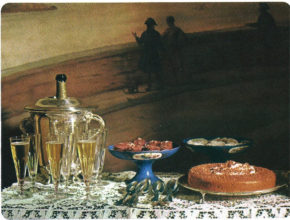Generally speaking, you rarely see place cards today unless you’re at a wedding. Personally, I wish they would make a comeback. I’ve been to a lot of dinners where people approach the table and then hover, looking nervous and wondering where they should park their butts. When you don’t tell people where to sit, couples sit with each other, everyone tries to sit next to the host and no one sits next to the shy. When you choose who sits next to who you can put the talker next to the taciturn, (who is an able audience). Separate the couples and allow them to speak to new and different people. It’s the basics of hosting.
“History tells us that the very earliest place cards known were used in 1589 at the marriage of the Grand Constable of Naples. When the guests entered the grand dining hall they found at each cover a little silver page holding aloft a silver shield, each one with the coat of arms of the guest on it. Of course they sat down at the place which bore their own crests.”
American Cookery, October 1931
Place cards only really started to trickle down to the masses in the Victorian era. Before that, unless it was a large banquet, people went into the dining room keenly aware of everyone’s rank in society. In the regency era, there were set orders of precedence which dictated exactly where someone sat at a table. Place cards were generally unnecessary under those circumstances. However, with the birth of the Steam Engine Era, social mobility increased as well as physical mobility, and one was likely to come in contact with many more people who had much murkier standings in society. At this point, place cards became a necessity rather than a luxury.
In Social Etiquette of New York (1879), it is said that “Cards, either plain or ornamental, according to the taste or the ceremoniousness of the dinner, are laid at each lady’s and gentleman’s plate, with the names upon them. The menu card is usually hidden beneath it.”
Now, let me say that I don’t think anyone needs to adhere to old etiquette standards, I certainly don’t. What I am going to assert is that a “Formal Dinner” is only made formal by the adherence to certain rules. Just because your dinner isn’t technically formal, doesn’t mean it isn’t wonderful. But, going forward I’m going to mention some rules that define what formal means, if you want to throw a truly “Formal” dinner, you will need to follow these rules.
At a dinner, the cards themselves should be made of heavy card stock and measure somewhere near 2 inches by 3 inches. For a formal dinner they must be white or cream. If you have menu cards on the table as well as place cards, formal etiquette dictates that the two must be made of the exact same paper. If the menu card has a beveled, rounded or gilded edge, so must your place card. The only thing that can be different between the menu card and the place card is that the engraved decorations on the top of menu cards need not be on the place card. That includes crests, symbols and house names.
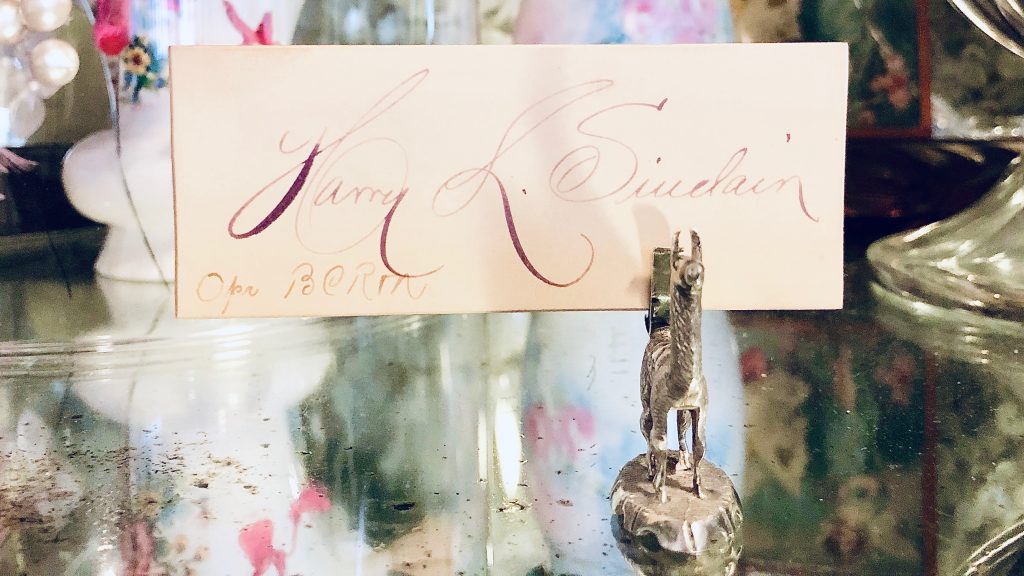
Make no mistake, at a formal dinner, place cards are required. There are very old examples of Menu cards that place the name of the guest at the top of the menu eliminating the need for the place card, but I find these confusing as most people won’t know where to look to find their seat.
For company or semi-formal dinners, you have some room to use a wider range of lighter weight papers, color and even designs. Just know the snobs say that decorated or colored place cards have no place except at public banquets or special occasions such as balls. On the opposing side, there are many people that do not use place cards for company or semi-formal dinners at all. Technically, it’s not incorrect, but I can’t say enough how much they help if you have people for dinner who don’t all know each other well.
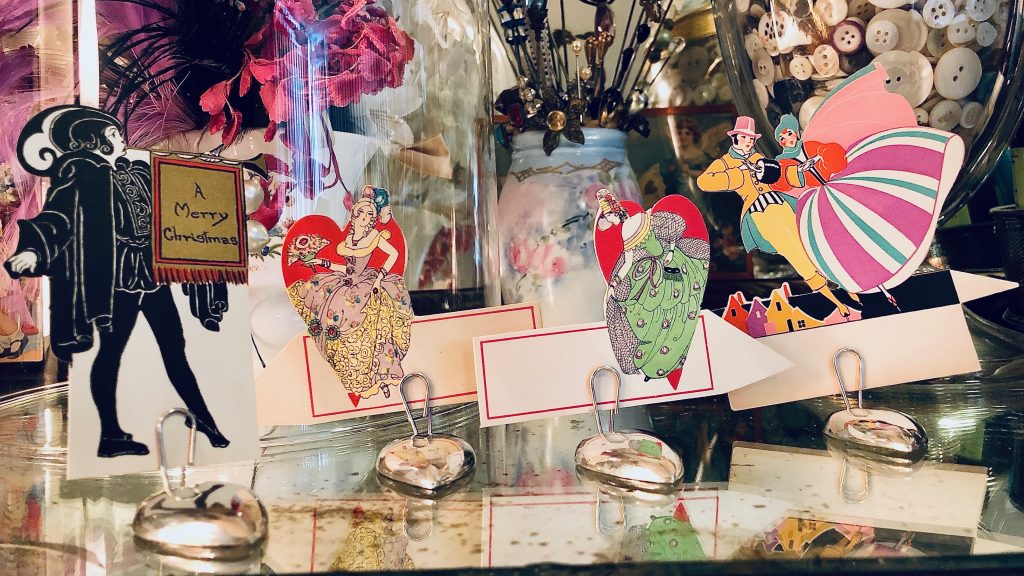
The rules of place cards are easy; if they are in a holder, place them directly above the plate, if they are loose lay them on the napkin folded on the place plate, (also known as the charger) and write in a large, clear hand. Calligraphy is always lovely, just make sure it’s readable. For formal events, you must write out the guests’ full names. When the meal is informal you may use first names or nicknames. Just no pet names. Everyone at the table does not need to know that you call your boyfriend “Boopie”. But then again, you do you.
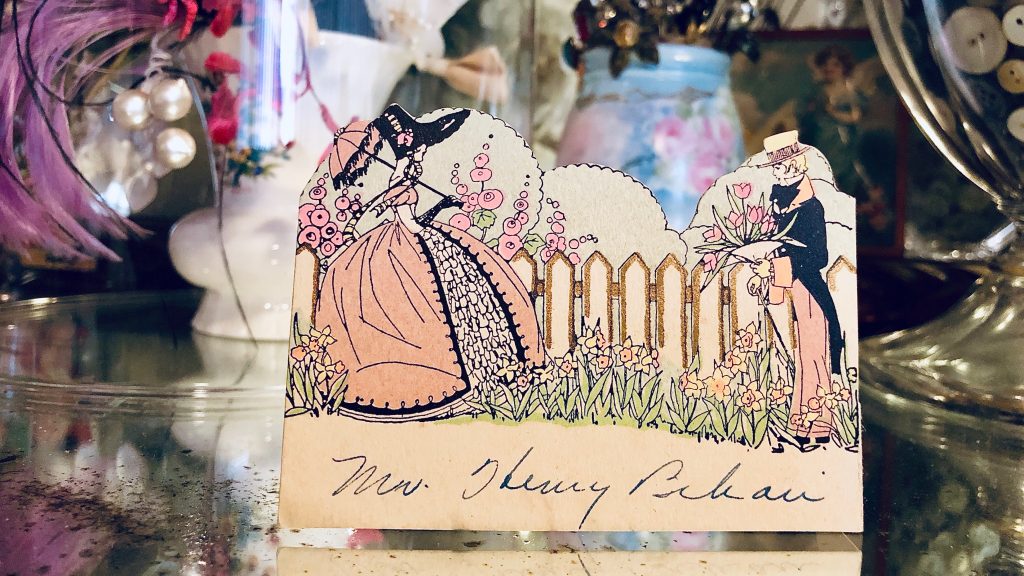
With modern folding place cards that are usually bigger, (3 inches by 3 ¼ inches) write the name in the lower half. Snobs will consider these fairly informal, even if they are lined with silver or gold.
Early place cards are very plain with the name written out in calligraphy or clear text. They were held in individual silver or gilt holders and sat directly above the plate. Victorian and Edwardian tables really perfected these, with sterling silver place card holders that were sculptural works of art. The Hunt Breakfast was an event where place card holders were really gorgeous. You don’t have to approve of a fox hunt to appreciate the artistry of a tiny sculpted fox or pheasant in sterling silver.
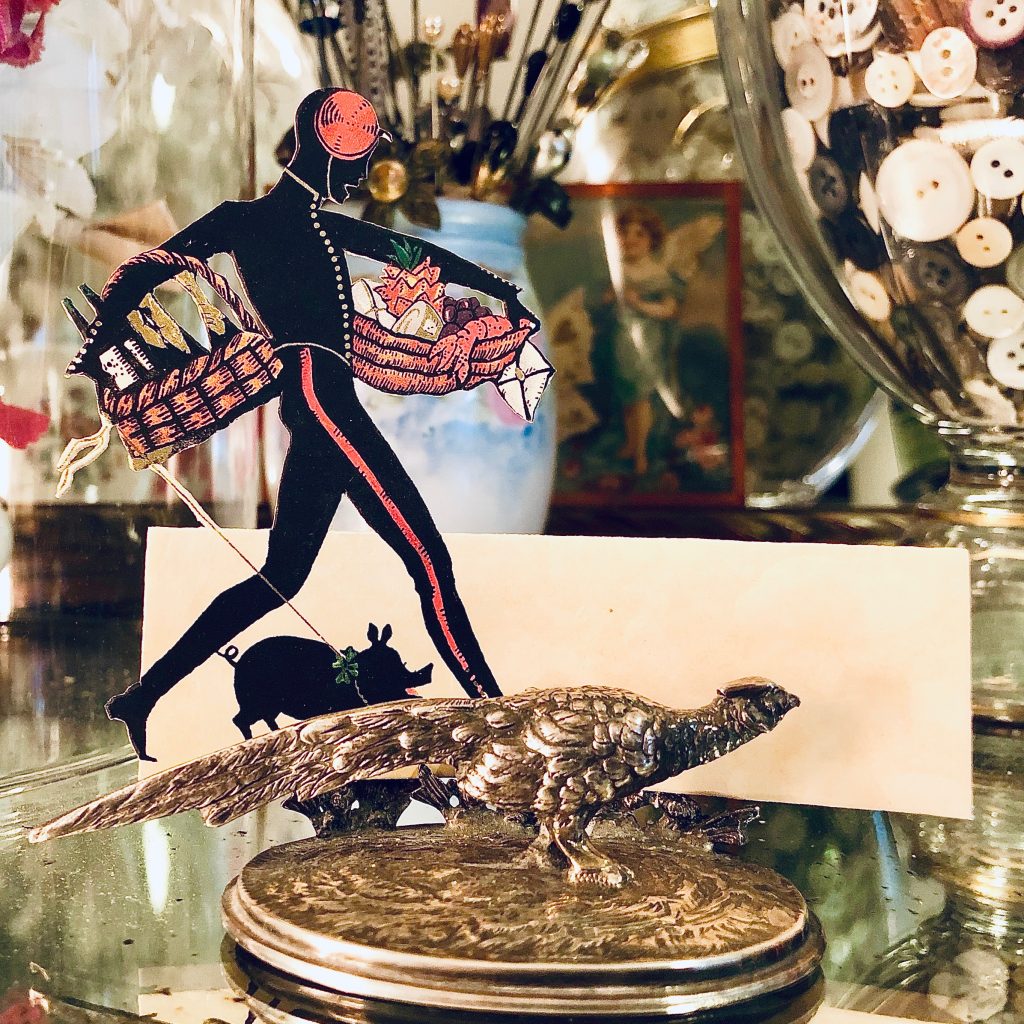
In the Victorian era one can see some stunning place cards featuring beautiful watercolors and drawings. There are many stunning French and German examples of this as well as British. As printing became cheaper during Victorian times and with the rise of a middle class, printed place cards featuring pretty or comical art began to appear. At first these were seen a novelties and might appear on even a wealthy person’s table for an informal luncheon or breakfast. But as they became more ubiquitous and cheaper to produce, they fell out of favor. Old timey snobs would not want to see printed cards on anything but a children’s table. Personally, I love them!

By the Edwardian period, printed place cards proved popular for dances, informal parties and college events. As sororities became increasingly common with college women, themed place cards, menu cards and dance programs became all the rage for the myriad of events each gal would attend. Dennison produced not only catalogs designed to sell goods, but Party Magazine to give advice on how to throw and decorate events, big and small – and on every table, there were themed place cards. The middle class too embraced these little paper treasures and their diversity of design and type exploded.
By the 1910’s and 20’s, erasable porcelain or glass place cards appear. The benefit of these is that one could use them again and again. These really took hold with the rise of bridge parties. Now, these can make a table look beautiful, but they are not considered to be “the thing” for anything but game tables by the snobs. They will say that entertaining is about spoiling one’s guests so open shows of frugality are not appropriate. Whatever. If you’ve got the style, do whatever you like.
You’ll also begin to see combination place card/bridge tallies beginning in the late teens, early 1920’s. Companies like Dennison and Buzza made gorgeous examples and there are really fun sets still to be found.
Also lovely are the combination nut cup and place card seen at luncheons. Relegated to lunches, games and afternoon social functions, nut cups were placed above each person’s plate to give guests something to nosh on while speeches were made, poetry read or games played. Foldable paper dishes became popular for their convenience and as a souvenir or the event.

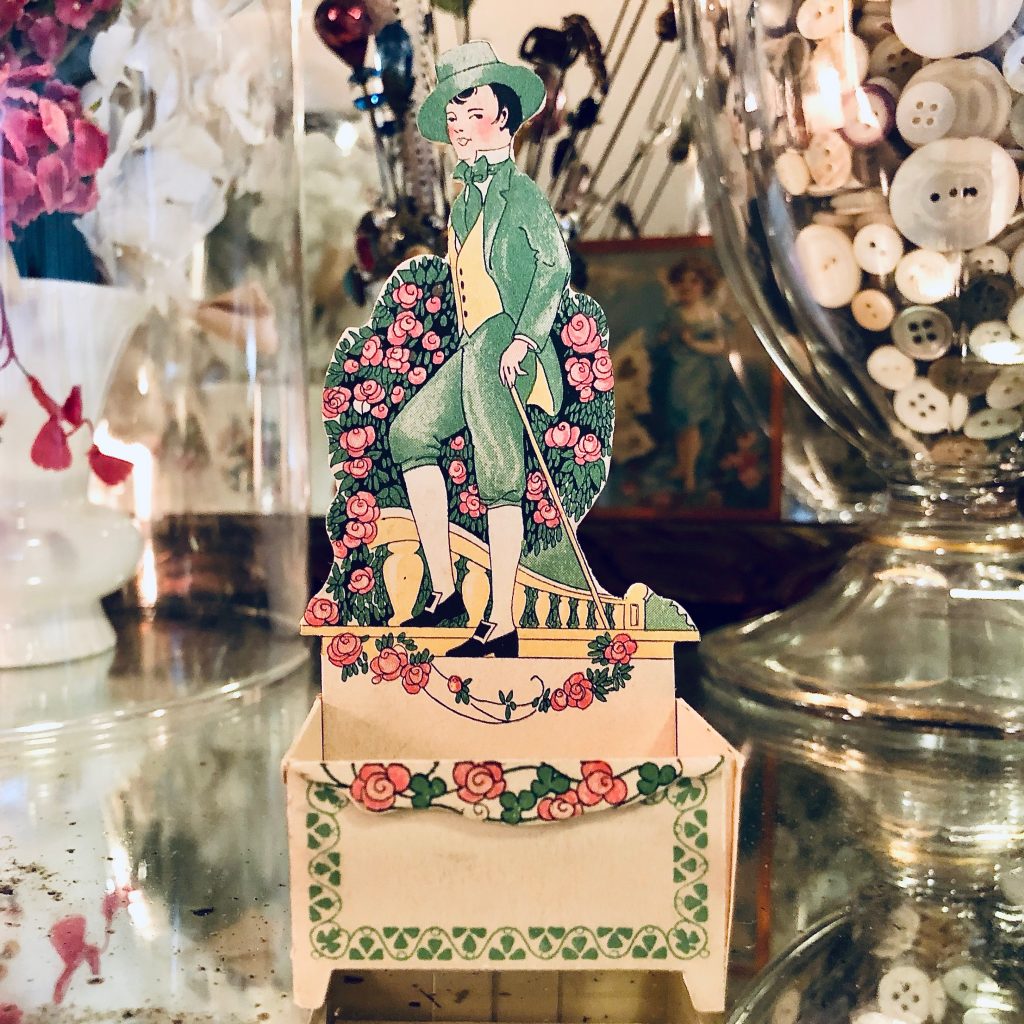
Dennison maintained it’s standing as the king of American paper party products from the 1900’s well into the 1950’s. They made paper place cards that stood on their own as well as the kind that were placed into holders. Highly collectable, these are hard to find, but still look amazing on an informal or holiday table. Their St. Patrick’s Day, Halloween and Christmas place cards are particularly adorable.
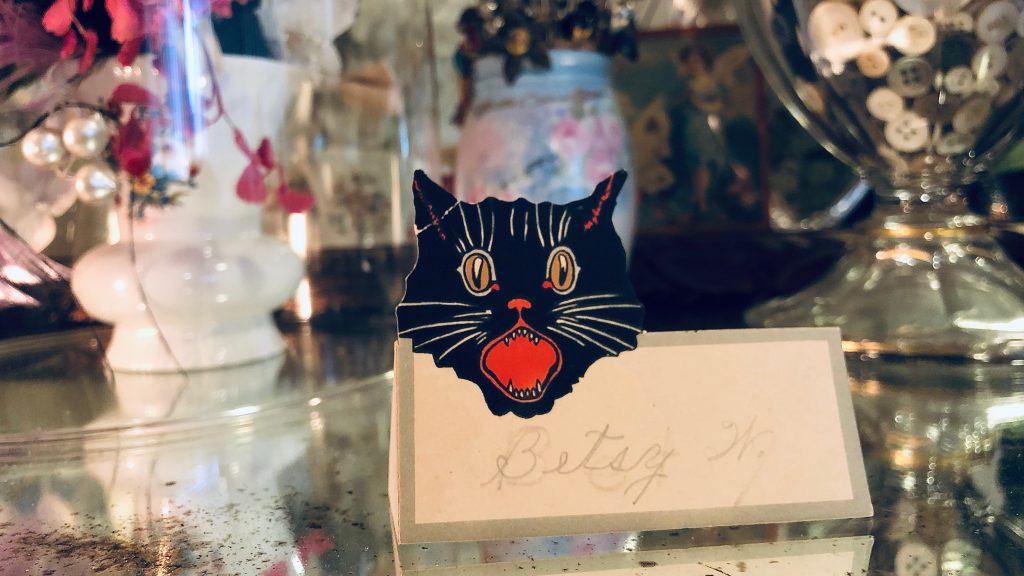
I do draw the line at Kitsch place card holders that show up in the 1950’s. Unless you’re having a theme party or are specifically trying to be wacky, I’m going to take a train to snobland and say that adults do not need their names held by clowns or twee plastic animals. Place card holders from the 1970’s and 1980’s are particularly hideous with pink glass elephants holding balloons and mixed metal atrocities. As always, there are exceptions. Hallmark made some hilarious paper place card holders in the seventies that can be used in an ironic hipster way to great effect, so let your style, (and guests) be your guide. In the end, it’s whatever makes you happy.
If you’re hoping to start collecting place cards, I would suggest estate sales, Ebay and Etsy. The days where you found these at thrift stores have sadly passed, though you can easily find modern ones there now, usually left over from someone’s wedding. If someone is charging you over a few dollars a card, make sure they are in mint condition. This is where it really helps to know your sellers. Dennison and Buzza place cards can get around ten dollars if they are especially old, in mint condition and/or Halloween related. But be careful. Sellers sometimes see that something is Dennison and so charge an arm and a leg despite the fact that it’s in a less desirable category or condition. Worse, sellers will see a Dennison or Buzza card from the 1920’s selling for packet and mark their no-name 1920’s place card for the same amount. Don’t get sucked in. There are still lots of these out there for reasonable prices. Buying in bulk helps, but if you’re online, make sure to check your photographs for condition. Everything has come down in price over the last ten years as the internet made people realize that things they thought were rare, really weren’t. Paper collectables are at the forefront of this. Not to mention, fewer and fewer people use or collect these old table items. So be very, very wary.
I hope you are invited to many wonderful dinners where you are seated next to hilarious and entertaining people. I’m sending you love and good wishes, Cheri.


